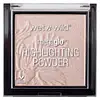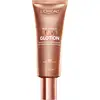What's inside
What's inside
 Key Ingredients
Key Ingredients

 Benefits
Benefits

 Concerns
Concerns

 Ingredients Side-by-side
Ingredients Side-by-side

Mica
Cosmetic ColorantSynthetic Fluorphlogopite
Dimethicone
EmollientBoron Nitride
AbsorbentOctyldodecyl Stearoyl Stearate
EmollientTrimethylsiloxysilicate
EmollientEthyl Macadamiate
Skin ConditioningPolysorbate 20
EmulsifyingPhytosteryl Macadamiate
Skin ConditioningCaprylic/Capric Triglyceride
MaskingPhenoxyethanol
PreservativeSorbitan Stearate
EmulsifyingTin Oxide
AbrasiveCaprylyl Glycol
EmollientMagnesium Aluminum Silicate
AbsorbentHexylene Glycol
EmulsifyingEthylhexylglycerin
Skin ConditioningWater
Skin ConditioningNylon-12
Silica
AbrasiveO-Cymen-5-Ol
AntimicrobialPolyacrylamide
Tocopheryl Acetate
AntioxidantC13-14 Isoparaffin
EmollientLaureth-7
EmulsifyingTriethoxycaprylylsilane
Tocopherol
AntioxidantLauroyl Lysine
Skin ConditioningCI 77891
Cosmetic ColorantCI 77491
Cosmetic ColorantCI 77492
Cosmetic ColorantCI 77499
Cosmetic ColorantMica, Synthetic Fluorphlogopite, Dimethicone, Boron Nitride, Octyldodecyl Stearoyl Stearate, Trimethylsiloxysilicate, Ethyl Macadamiate, Polysorbate 20, Phytosteryl Macadamiate, Caprylic/Capric Triglyceride, Phenoxyethanol, Sorbitan Stearate, Tin Oxide, Caprylyl Glycol, Magnesium Aluminum Silicate, Hexylene Glycol, Ethylhexylglycerin, Water, Nylon-12, Silica, O-Cymen-5-Ol, Polyacrylamide, Tocopheryl Acetate, C13-14 Isoparaffin, Laureth-7, Triethoxycaprylylsilane, Tocopherol, Lauroyl Lysine, CI 77891, CI 77491, CI 77492, CI 77499
Water
Skin ConditioningGlycerin
HumectantCyclohexasiloxane
EmollientAlcohol Denat.
AntimicrobialSynthetic Fluorphlogopite
Butyrospermum Parkii Butter
Skin ConditioningDimethicone
EmollientAmmonium Polyacryloyldimethyl Taurate
Emulsion StabilisingPolyglyceryl-6 Distearate
EmulsifyingMica
Cosmetic ColorantCI 77891
Cosmetic ColorantPolysilicone-11
Phenoxyethanol
PreservativePentaerythrityl Tetraethylhexanoate
EmollientCI 77491
Cosmetic ColorantJojoba Esters
EmollientCapryloyl Salicylic Acid
ExfoliatingCaprylyl Glycol
EmollientPolyacrylamide
Boron Nitride
AbsorbentPolyglyceryl-3 Beeswax
EmulsifyingCetyl Alcohol
EmollientC13-14 Isoparaffin
EmollientAdenosine
Skin ConditioningDisodium EDTA
Laureth-7
EmulsifyingSodium Hydroxide
BufferingTin Oxide
AbrasiveCitric Acid
BufferingCeramide AP
Skin ConditioningWater, Glycerin, Cyclohexasiloxane, Alcohol Denat., Synthetic Fluorphlogopite, Butyrospermum Parkii Butter, Dimethicone, Ammonium Polyacryloyldimethyl Taurate, Polyglyceryl-6 Distearate, Mica, CI 77891, Polysilicone-11, Phenoxyethanol, Pentaerythrityl Tetraethylhexanoate, CI 77491, Jojoba Esters, Capryloyl Salicylic Acid, Caprylyl Glycol, Polyacrylamide, Boron Nitride, Polyglyceryl-3 Beeswax, Cetyl Alcohol, C13-14 Isoparaffin, Adenosine, Disodium EDTA, Laureth-7, Sodium Hydroxide, Tin Oxide, Citric Acid, Ceramide AP
 Reviews
Reviews

Ingredients Explained
These ingredients are found in both products.
Ingredients higher up in an ingredient list are typically present in a larger amount.
Boron Nitride is compound consisting of boron and nitrogen. It is used to absorb oil and modify adherence/ slip in products.
This means it is often used in makeup products to help them last longer.
This ingredient is also known as "C13-14 Isoalkane".
C13-14 Isoparaffin is created from petroleum-based mineral oils. It is an emollient and helps thicken a product.
As an emollient, it helps keep the skin soft and smooth by creating a barrier on top. This barrier traps moisture in, keeping the skin hydrated.
C13-14 Isoparaffin may not be fungal-acne safe.
Learn more about C13-14 IsoparaffinCaprylyl Glycol is a humectant and emollient, meaning it attracts and preserves moisture.
It is a common ingredient in many products, especially those designed to hydrate skin. The primary benefits are retaining moisture, skin softening, and promoting a healthy skin barrier.
Though Caprylyl Glycol is an alcohol derived from fatty acids, it is not the kind that can dry out skin.
This ingredient is also used as a preservative to extend the life of products. It has slight antimicrobial properties.
Learn more about Caprylyl GlycolCi 77491 is also hydrated iron III oxide. It's sole purpose is to give a red/pink hue to products.
Iron III oxides are classified as inorganic chemicals for coloring.
Synthetically created Ci 77491 is considered safer than those naturally found. This is because the synthetically created version may contain less impurities. Iron oxides are generally non-toxic and non-allergenic.
Learn more about CI 77491Ci 77891 is a white pigment from Titanium dioxide. It is naturally found in minerals such as rutile and ilmenite.
It's main function is to add a white color to cosmetics. It can also be mixed with other colors to create different shades.
Ci 77891 is commonly found in sunscreens due to its ability to block UV rays.
Learn more about CI 77891Dimethicone is a type of synthetic silicone created from natural materials such as quartz.
What it does:
Dimethicone comes in different viscosities:
Depending on the viscosity, dimethicone has different properties.
Ingredients lists don't always show which type is used, so we recommend reaching out to the brand if you have questions about the viscosity.
This ingredient is unlikely to cause irritation because it does not get absorbed into skin. However, people with silicone allergies should be careful about using this ingredient.
Note: Dimethicone may contribute to pilling. This is because it is not oil or water soluble, so pilling may occur when layered with products. When mixed with heavy oils in a formula, the outcome is also quite greasy.
Learn more about DimethiconeLaureth-7 is created by the ethoxylation of lauryl alcohol using ethylene oxide. Lauryl alcohol is a fatty alcohol with hydrating properties.
This ingredient is an emulsifier and cleansing ingredient. As an emulsifier, it is used to prevent ingredients from separating. It also helps cleanse the skin by gathering dirt, oil, and pollutants to be rinsed away.
Mica is a naturally occurring mineral used to add shimmer and color in cosmetics. It can also help improve the texture of a product or give it an opaque, white/silver color.
Serecite is the name for very fine but ragged grains of mica.
This ingredient is often coated with metal oxides like titanium dioxide. Trace amounts of heavy metals may be found in mica, but these metals are not harmful in our personal products.
Mica has been used since prehistoric times throughout the world. Ancient Egyptian, Indian, Greek, Roman, Aztec, and Chinese civilizations have used mica.
Learn more about MicaPhenoxyethanol is a preservative that has germicide, antimicrobial, and aromatic properties. Studies show that phenoxyethanol can prevent microbial growth. By itself, it has a scent that is similar to that of a rose.
It's often used in formulations along with Caprylyl Glycol to preserve the shelf life of products.
Polyacrylamide is a synthetic polymer. It is used to stabilize products and bind ingredients. When hydrated, Polyacrylamide forms a soft gel.
Polyacrylamide is low-toxicity. If source properly, it is deemed safe to use in cosmetics.
It should be noted the precursor to Polyacrylamide is acrylamide. Acrylamide is a carcinogen. Most reputable sources of Polyacrylamide will screen for residual acrylamide to make sure the count is in a safe range. Acrylamide is not able to be absorbed through the skin.
We recommend speaking with a professional if you have concerns.
Learn more about PolyacrylamideSynthetic Fluorphlogopite is the synthethic version of mica. It consists of fluorine, aluminum and silicate.
Synthetic Fluorphlogopite is used to add volume to products.
It is considered non-irritating on the skin.
Learn more about Synthetic FluorphlogopiteTin Oxide is an inorganic oxide used to add opacity and volume to a product. In nature, it is already found in mineral form. The main ore of tin is an opaque and shiny mineral called casseterite.
Tin Oxide helps remove translucency in a product, or make it more opaque. Besides adding opacity, tin oxide is used for bulking to add volume.
Water. It's the most common cosmetic ingredient of all. You'll usually see it at the top of ingredient lists, meaning that it makes up the largest part of the product.
So why is it so popular? Water most often acts as a solvent - this means that it helps dissolve other ingredients into the formulation.
You'll also recognize water as that liquid we all need to stay alive. If you see this, drink a glass of water. Stay hydrated!
Learn more about Water